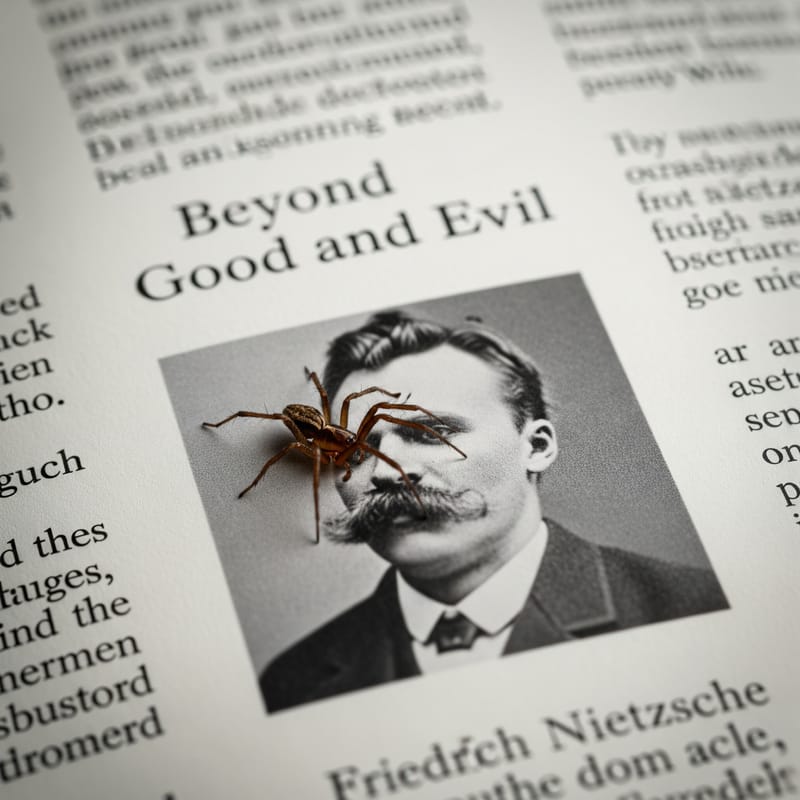Let the Spider Be a Spider: A Re-evaluation of Nietzsche’s Philosophical Zoo
There are moments in reading philosophy when a single sentence can snag on your mind, unraveling a thread you didn’t even know was there. For me, this happened recently while revisiting Friedrich Nietzsche. I was deep in his work, admiring the ferocious genius with which he uses his menagerie of animals—the lion, the camel, the eagle, the serpent—to tear down the rickety stage of traditional morality. And then I came to the spider.
Nietzsche uses the spider as a metaphor for the human intellect, spinning intricate conceptual webs out of itself, often mistaking these self-made constructs for reality. He suggests that the webs of metaphysics are unhealthy, but that “we, spiders,” can learn to spin “different, life-affirming, healthier, non-metaphysical cobwebs.” And that’s when the thread pulled.
Something about it felt profoundly wrong. I found myself thinking about a real spider. It doesn’t sting out of hate or spin its web from trauma. It does so to live. It is a pure expression of its nature. To ask it to spin a “better” or “healthier” web is to misunderstand it completely. It’s to demand that it stop being a spider and become a philosopher. A nagging question took root in my mind, a question I wanted to pose directly to the great thinker himself: Why do you want the spider to be anything else but a spider?
This question became a key, unlocking a new way to look at Nietzsche’s entire philosophical zoo. It revealed a subtle but persistent paradox: in his brilliant effort to critique human values, Nietzsche constantly projects his own set of human values onto the very animals he uses as symbols. He doesn’t let them be themselves.
Consider his famous allegory of the birds of prey and the lambs. For Nietzsche, the powerful "beast of prey" acts from a natural, innocent strength, while the lambs, in their weakness, invent a "slave morality" born of ressentiment—a poisonous, life-denying bitterness. He diagnoses this as a sickness. But applying our question here: why shouldn't the lamb resent the eagle? From the lamb’s perspective, creating a moral code that favors the flock is an ingenious survival strategy. It’s the lamb using the tools at its disposal to continue existing. To call this a sickness is to judge the lamb for not being a predator. It’s a failure to recognize that, as I’ve explored before, “normal is a moving target.” The lamb’s normal is not the eagle’s, and to pathologize its nature is to impose a single, predatory standard on all of existence.
This pattern continues in his "Three Metamorphoses," the spiritual journey from camel to lion to child. The camel is the dutiful spirit, kneeling to accept the heaviest burdens of tradition. The lion is the rebellious spirit who says a “sacred No” to duty. And the child is the creator of new values, the ultimate goal. But why is this progression necessary? Why is the camel’s nature—its profound strength in endurance—framed as an inferior stage to be overcome? There is a unique power in the camel’s ability to bear weight. By demanding this transformation, Nietzsche imposes a specific, linear path of growth. It challenges the very idea I’ve explored in “The Alchemy of Becoming,” making me wonder if genuine growth is always about shedding our past selves, or if there is also a quiet nobility in simply being what we are, with all the weight we’ve chosen to carry.
Even in his most synthetic and beautiful metaphor—the eagle and the serpent—this subtle hierarchy persists. The eagle represents the highest spirit, and the serpent the deepest instincts. Nietzsche’s ideal is their union, the serpent coiled around the eagle’s neck as a friend, soaring together. It’s a powerful image of integration. But look closer. The serpent is still being lifted from its domain. Its earth-bound wisdom is implicitly validated only when it is raised into the sky by the spirit. Why can’t the serpent’s cunning be sufficient on its own terms? Again, the animal is asked to become something more than itself to fit a human ideal of wholeness.
In asking these questions, I found I wasn’t entirely alone. Philosophers like Jacques Derrida have pointed out that the entire Western tradition has a habit of doing this. It defines "Man" by setting him against a single, flattened-out concept of "the Animal," a backdrop against which human uniqueness can be staged. Derrida even invented the term animot to remind us that "the animal" is just a word (mot in French), a human construct that erases the staggering diversity of actual living creatures.
Nietzsche, the great challenger of philosophical traditions, seems to have fallen into this very trap. He uses animals to hold up a mirror to humanity, but he seems disappointed when they don’t reflect his own vision of what humanity should become.
This brings me back to a theme I find myself returning to again and again: that “context is for kings.” We, as human thinkers, place ourselves as the kings of context, using the animal kingdom as a grand narrative to tell stories about our own power, our own psychology, our own potential for greatness. We look at the spider, the lamb, and the serpent, and we demand they tell us something profound about ourselves.
But perhaps the most profound lesson they can teach us is one we resist hearing: that they are not here for us. They are not symbols waiting to be decoded. They are simply living their own lives, by their own natures. The spider stings. The lamb fears. The serpent crawls. And maybe the greatest philosophical challenge isn't to translate them into our world, but to find the humility to let them be, entirely and unapologetically, themselves.

